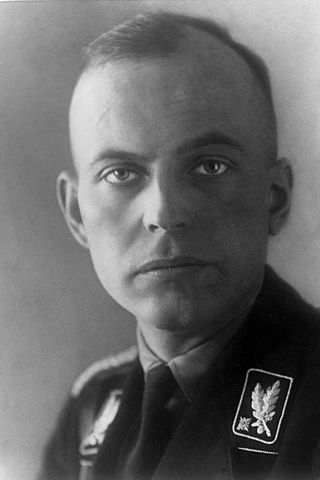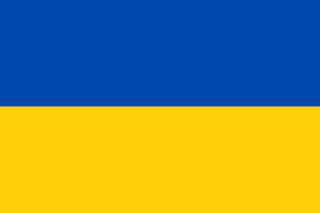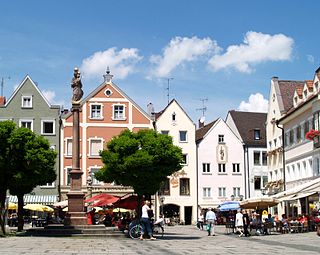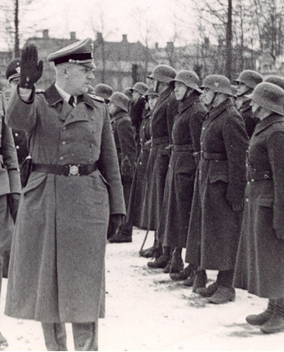Related Research Articles

Braunschweig or Brunswick is a city in Lower Saxony, Germany, north of the Harz Mountains at the farthest navigable point of the river Oker, which connects it to the North Sea via the rivers Aller and Weser. In 2016, it had a population of 250,704.

Friedrich Jeckeln was a German SS commander during the Nazi era. He served as a Higher SS and Police Leader in the occupied Soviet Union during World War II. Jeckeln was the commander of one of the largest collection of Einsatzgruppen death squads and was personally responsible for ordering and organising the deaths of over 100,000 Jews, Romani and others designated by the Nazis as "undesirables". After the end of World War II in Europe, Jeckeln was convicted of war crimes by a Soviet military tribunal in Riga and executed in 1946.

The University of Duisburg-Essen is a public research university in North Rhine-Westphalia, Germany. In the 2019 Times Higher Education World University Rankings, the university was awarded 194th place in the world. It was originally founded in 1654 and re-established on 1 January 2003, as a merger of the Gerhard Mercator University of Duisburg and the university of Essen. It is based in both the cities of Duisburg and Essen, and a part of University Alliance Metropolis Ruhr.

Dietrich Klagges was a Nazi Party politician and from 1933 to 1945 the appointed premier (Ministerpräsident) of the now abolished Free State of Brunswick. He also went by the pseudonym Rudolf Berg.

Hans-Adolf Prützmann was among the highest-ranking German SS officials during the Nazi era. From June 1941 to September 1944, he served as a Higher SS and Police Leader in the occupied Soviet Union, and from November 1943 was the Supreme SS and Police Leader in Ukraine. He oversaw the activities of the Einsatzgruppen detachments that perpetrated the Holocaust in the Baltic States and Ukraine. After being captured at the end of the Second World War, he committed suicide.
Hermann Ulrich Kantorowicz was a German jurist.

The Free State of Brunswick was a state of the German Reich in the time of the Weimar Republic. It was formed after the abolition of the Duchy of Brunswick in the course of the German Revolution of 1918–19. Its capital was Braunschweig (Brunswick).

Ernst Pöhner was Munich's Chief of Police from 1919 to 1922. He was a vigorous anti-communist and anti-Semite who was in office when Bavarian Minister President Gustav Ritter von Kahr had Ostjuden, or "Eastern Jews", expelled from Bavaria. As part of an anti-Semitic campaign throughout Germany in 1920, Kahr ordered the mass expulsion from Bavaria of the so-called Eastern Jews, many of whom had lived there for generations.

Adelebsen is a municipality in the district of Göttingen, in Lower Saxony, Germany. It consists of the localities Adelebsen, Barterode, Eberhausen, Erbsen, Güntersen, Lödingsen and Wibbecke. The Burg Adelebsen is located on a high point in Adelebsen proper.

The Kamianets-Podilskyi massacre was a World War II mass shooting of Jews carried out in the opening stages of Operation Barbarossa, by the German Police Battalion 320 along with Friedrich Jeckeln's Einsatzgruppen, Hungarian soldiers, and the Ukrainian Auxiliary Police. The killings were conducted on August 27 and August 28, 1941, in the Soviet city of Kamianets-Podilskyi, occupied by German troops in the previous month on July 11, 1941. According to the Nazi German reports a total of 23,600 Jews were murdered, including 16,000 who had earlier been expelled from Hungary.

Weilheim in Oberbayern is a town in Germany, the capital of the district Weilheim-Schongau in the south of Bavaria. Weilheim has an old city-wall, historic houses and a museum.

Verband für das Deutsche Hundewesen (VDH) is Germany's kennel club for dogs and represents Germany in the world federation Fédération Cynologique Internationale. It is headquartered in Dortmund, Germany.
Friedrich Alpers was a German Nazi politician, a Luftwaffe officer and an SS-Obergruppenführer. He was also a Minister of the Free State of Brunswick, and Generalforstmeister in the government of Nazi Germany. Alpers was responsible for numerous political crimes in Brunswick. He died during the Second World War, most likely by suicide.

Ulrich III von Graben was a member of the Austrian nobility, Lord of Kornberg, (Ober)Radkersburg, Grabenhofen, Graben and the Lordship Marburg, Obermarburg and Maribor Castle.

The following is a timeline of the history of the city of Braunschweig (Brunswick), Germany.

Heinrich Jasper was a German politician (SPD). During the 1920s, he served three terms as regional prime minister (Ministerpräsident) of the Free State of Brunswick. He died in the Bergen-Belsen concentration camp.
Werner Küchenthal was a German jurist and public official who became a leading politician in what was then the Free State of Brunswick .

Willy Spatz was a German painter and lithographer.

Hinrich Möller was a German SS-Brigadeführer and Generalmajor of Police. He served as police chief in Neumünster and Flensburg in the 1930s. During the Second World War, he was the SS and Police Leader (SSPF) "Estland". After the war, he was convicted of the 1934 murders of two Communist Party leaders and sent to prison.
References
- 1 2 Edith Raim (18 October 2013). Verbrechen an den politischen Gegnern bis 1933. p. 742. ISBN 978-3-486-73565-9.
{{cite book}}:|work=ignored (help) - 1 2 3 4 Rauhreif. "Landmann, Gerhard". Metapedia - der alternativen Enzyklopädie vorrangig für Kultur, Philosophie, Wissenschaft, Politik und Geschichte.
{{cite web}}: Missing or empty|url=(help) - ↑ Veit Veltzke (2009). Footnote 43. p. 388. ISBN 978-3-412-20340-5.
{{cite book}}:|work=ignored (help) - ↑ "Der Kampf um die Straße". Der Kampf der Bilder - Braunschweig im Spiegel der Fotografie, 1930-1933. Arbeitskreises Andere Geschichte e.V. Retrieved 16 September 2016.
- ↑ "Ginkosteine 10/11 ... Rieseberg-Denkmal". Ulrich Schade l.A. Gedenkstätte für Opfer von Krieg und Gewaltherrschaft, Braunschweiger Friedhöfe e.V. Retrieved 16 September 2016.
- ↑ "Gerhard Landmann". Prof. Henning Freiberg i.A. Vernetztes Gedächtnis. Stadt Braunschweig. Retrieved 16 September 2016.
- ↑ "01. August 1933". Stadtchronik Braunschweig: Einträge für das Jahr 1933. Stadt Braunschweig. Retrieved 18 September 2016.
- ↑ "18. Januar 1934". Stadtchronik Braunschweig: Einträge für das Jahr 1934. Stadt Braunschweig. Retrieved 18 September 2016.
- ↑ Ulrich Kiehne (21 February 2014). "Eines großen Sozialdemokraten gedacht". Verlag Seesener Beobachter GmbH. Retrieved 18 September 2016.